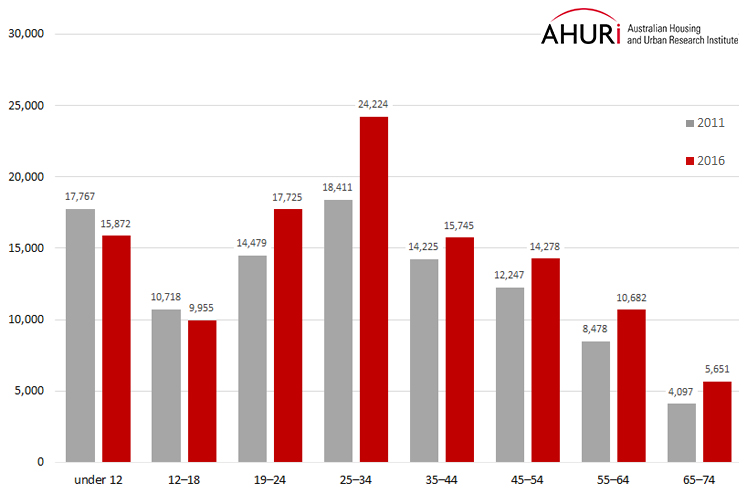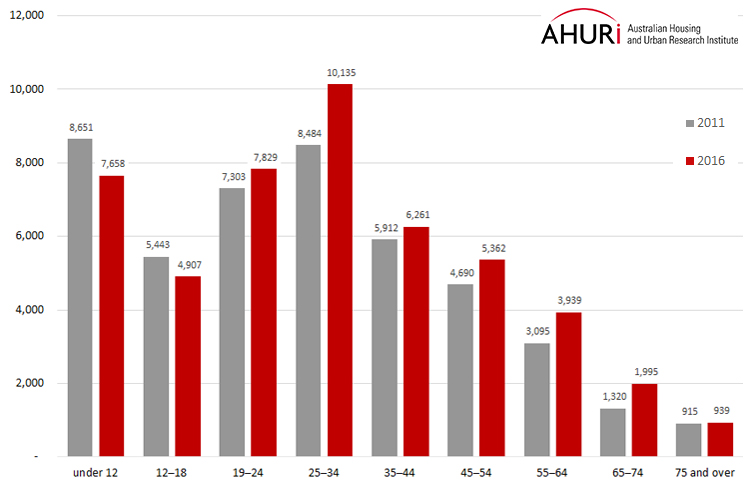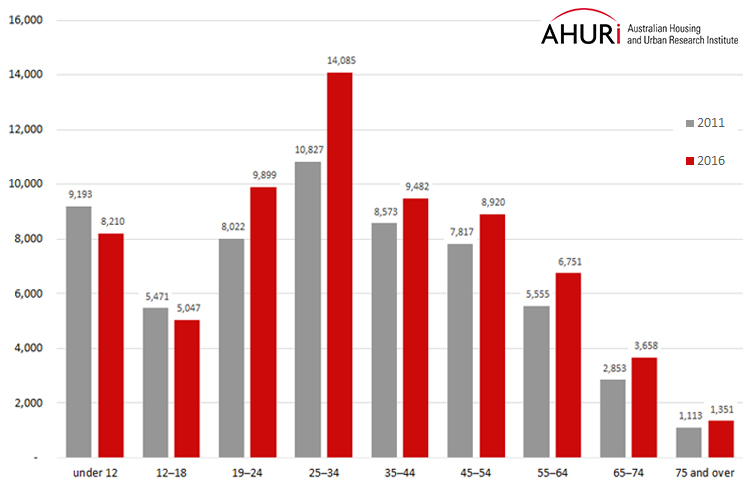This is the first of three AHURI Briefs that examines Census data to understand how homelessness is changing in Australia. Read the second and third Brief here.
The 2016 Census reveals that 116,427 people were experiencing homelessness in August 2016, which was a 13.7 per cent increase, or an additional 13,988 people, to the 2011 Census. Over the same time period Australia’s population rose by a smaller 8.8 per cent, from 21,507,717 people in 2011 to 23,401,892 in 2016.
In addition, the rate of homeless rose by 4.6 per cent, from 47.6 people experiencing homelessness for every 10,000 Australians in 2011 to 49.8 people in 2016.
Changes in categories of homelessness
When we look at the six categories of homelessness we find that the largest increases (both as percentage increase and number) since 2011 have been for persons living in 'severely' crowded dwellings, followed by persons living in improvised dwellings, tents, or sleeping out and persons living in boarding houses.
Table 1: Homelessness categories 2016
| Number in 2011 | Number in 2016 | % change | |
|---|---|---|---|
| Persons living in improvised dwellings, tents, or sleeping out | 6,810 | 8,200 | 20.40% |
| Persons in supported accommodation for the homeless | 21,258 | 21,235 | -0.10% |
| Persons staying temporarily with other households | 17,374 | 17,725 | 2.0% |
| Persons living in boarding houses | 14,944 | 17,503 | 17.10% |
| Persons in other temporary lodgings | 682 | 678 | -0.6% |
| Persons living in 'severely' crowded dwellings | 41,370 | 51,088 | 23.5% |
| All homeless persons | 102,439 | 116,427 | 13.7% |
Source: ABS Census of Population and Housing: Estimating homelessness, 2016
Changes in age characteristics of homelessness
For different age groups, the biggest number increase in homelessness between 2011 and 2016 is for people aged 25–34, with a 31.6 per cent increase, or an additional 5,813 people.
While the number of young Australians aged 18 years and younger experiencing homelessness is still very large (25,827 or 22.2% or all people experiencing homelessness) it has dropped by 2,658 individuals since 2011.
The biggest percentage increase is in the elderly population. There was a 37.9 per cent increase for those aged 65–74, equating to 1,554 more people being homeless. In part, this may be a reflection of the growing percentage of older Australians as the population ages.
Figure 1: Number of homeless by age, 2011 to 2016

Sources: ABS Census of Population and Housing: Estimating homelessness, 2016., ABS Census of Population and Housing: Estimating homelessness, 2011
Changes in gender characteristics of homelessness
There is also a very large 51.1 per cent increase in women in the age 65–74 group presenting as homeless. Unfortunately the Census can’t tell us why this is the case.
Nevertheless, the rise in older women being homeless may be the result of a number of factors including becoming homeless after ending relationships (through divorce or bereavement) or that traditionally female dominated jobs have had lower pay rates than male dominated jobs resulting in these women having insufficient savings (either in superannuation or in other savings vehicles) to provide for their retirement. The youngest of these women (i.e. aged 65 in 2016) would only have started receiving compulsory superannuation payments from employers when they were in their early forties and so would not have been able to build up a sustainable superannuation balance, particularly if they had been out of the workforce for a period of time looking after children or, perhaps later on, caring for sick family members.
In addition, for people who don’t own their own home, the single age pension (max. $453.80 per week in March 2018) may be insufficient to provide for housing for a single person in metropolitan higher rent areas.
Figure 3: Number of female homeless by age, 2011 to 2016

Sources: ABS Census of Population and Housing: Estimating homelessness, 2016., ABS Census of Population and Housing: Estimating homelessness, 2011
Figure 3: Number of male homeless by age, 2011 to 2016

Sources: ABS Census of Population and Housing: Estimating homelessness, 2016., ABS Census of Population and Housing: Estimating homelessness, 2011

